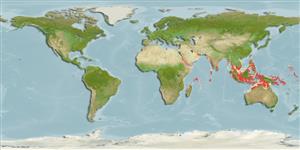>
Tetraodontiformes (Puffers and filefishes) >
Monacanthidae (Filefishes)
Etymology: Paramonacanthus: Greek, para = the side of + Greek, monos = one + Greek, akantha ) thorn (Ref. 45335).
Environment: milieu / climate zone / depth range / distribution range
Ekologi
laut dasar (demersal); kisaran kedalaman 10 - 50 m (Ref. 90102). Tropical
Indian Ocean: both sides of India, and across to the western coast of Thailand. A small post-pelagic juvenile has been collected from the Maldives.
Size / Weight / umur
Maturity: Lm ? range ? - ? cm
Max length : 10.0 cm SL jantan/; (Ref. 48637)
deskripsi pendek
Morfologi | Morfometrik
Duri punggung (Keseluruhan (total)): 2; duri punggung lunak (Keseluruhan (total)): 26-29; Duri dubur 0; Sirip dubur lunak: 27 - 30; vertebrata, bertulang belakang: 19. Body width 1.9-2.5 in head length; body depth 2.0-2.8 in SL; head length 2.6-3.0 in SL; snout length 3.7-4.3 in SL; eye diameter 2.7-3.8 in head length. Head and body pale, with three wide, darker but rather indistinct stripes on body, first from eye to anterior half of soft dorsal base, second from above gill opening, continuing posteriorly to rear half of soft dorsal base, and third curving up from ventral flap, extending along midside of body to caudal peduncle; two prominent dark blotches separated by a pale wedge-shaped bar below anterior portion of soft dorsal fin; caudal fin with dusky basal blotch, followed by two dark curved cross bands.
Inhabits muddy substrates in estuaries and usually found near algae rubble reef (Ref. 48637). Also found in sand bottoms of trawling grounds in 10-50 m (Ref. 90102).
Life cycle and mating behavior
Kematangan | Reproduksi, perkembang biakan | Pemijahan | telur-telur | Fecundity | Larva
Hutchins, J.B., 1997. Review of the monacanthid fish genus Paramonacanthus, with descriptions of three new species. Rec. West. Aust. Mus. Suppl. No. 54:1-57. (Ref. 33065)
Status IUCN Red List (Ref. 130435)
ancaman kepada manusia
Harmless
penggunaan manusia
informasi lanjut
Nama-nama umumSinonim (persamaan)metabolismePemangsaEkotoksikologiReproduksi, perkembang biakanKematanganPemijahanSpawning aggregationFecunditytelur-telurpekembangan telor
AcuanBudidaya airprofil budidaya airStrainGenetikaElectrophoresesDiturunkanPenyakit-penyakitPengolahanNutrientsMass conversion
mitraGambarStamps, Coins Misc.Suara-suaraCiguateraKecepatanTipe renangArea insangOtolithsOtakPenglihatan / visi
Alat, peralatan
laporan khas
muat turun XML
Sumber internet
Estimates based on models
Preferred temperature (Ref.
123201): 27.5 - 29.2, mean 28.6 °C (based on 576 cells).
Phylogenetic diversity index (Ref.
82804): PD
50 = 0.5000 [Uniqueness, from 0.5 = low to 2.0 = high].
Bayesian length-weight: a=0.01995 (0.00943 - 0.04220), b=2.93 (2.75 - 3.11), in cm total length, based on LWR estimates for this (Sub)family-body shape (Ref.
93245).
Trophic level (Ref.
69278): 3.1 ±0.3 se; based on size and trophs of closest relatives
Daya lenting (Ref.
120179): Tinggi, Waktu penggandaan populasi minimum kurang dari 15 bulan (Preliminary K or Fecundity.).
Fishing Vulnerability (Ref.
59153): Low vulnerability (10 of 100).
